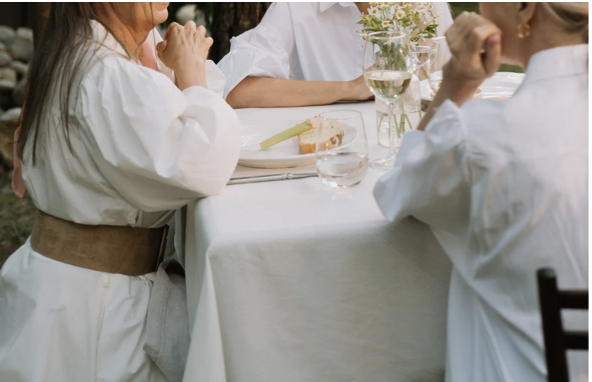In the world of etiquette, some rules seem almost instinctive, like the classic “no elbows on the table” rule. But why is this simple guideline so ingrained in our cultural consciousness and why do we do it? Believe it or not, this age-old etiquette rule began in the medieval era! Here is how it started, and more importantly, why we still practice the “no elbows on the table” in modern etiquette:
Historical Roots: A Glimpse into Medieval Times
The origins of the “no elbows on the table” rule date back to medieval times. During this period, dining was a communal activity, often involving large groups gathered around long, narrow tables. Below you can read the three main reasons why elbows were not allowed on the table in medieval times, and further below that, why we still keep them off tables today!
- Space and Safety: In medieval halls, tables were packed with diners, and space was at a premium. Having elbows on the table would crowd others and increase the risk of knocking over food and drink. Additionally, it was seen as a sign of aggression to keep your elbows on the table because it was a sign you may be ready to fight at any given second.
- Sign of Respect: Elbows on the table were seen as a sign of disrespect and a lack of self-control. In a society where manners and social hierarchy were crucial, maintaining proper decorum was essential. Keeping one’s elbows off the table showed respect for fellow diners and the host.
- Symbol of Nobility: Good posture was a mark of nobility and refinement. Sitting up straight with hands in the lap or gently resting on the edge of the table demonstrated poise and grace, qualities highly valued in medieval society.
Practical Reasons: Why the Rule Still Matters Today
While we no longer dine in medieval halls, the “no elbows on the table” rule has stood the test of time. Here’s why it remains relevant and important in modern dining:
- Creating Space: In today’s world, dining tables might not be as crowded as in medieval times, but respecting personal space is still crucial. Keeping your elbows off the table ensures there’s ample room for everyone to enjoy their meal comfortably. You also are likely to not tip over a glass, bump a cup of coffee, or lean into a meal if you keep your elbows off the table!
- Promoting Good Posture: Sitting with good posture not only shows good etiquette by being attentive and alert to your fellow dining companion but also benefits your health. Good posture helps with digestion and prevents discomfort that can arise from slouching or leaning on the table.
- Uneven tables: The moment you rest elbows on an uneven table, you are likely to see the food and drinks on the table lose their steady nature as well. Sometimes you may not know a table is uneven until you put pressure on an elbow on a table, so keeping them off can ensure no hot drinks or food fly onto the laps of guests!
- Respecting Tradition: After centuries, this etiquette rule of no elbows on the table actually has shaped our cultural norms to demonstrate respect for the shared experience of dining. Often putting elbows on the table now would be considered bad manners and disrespectful even if the table wasn’t uneven or there was plenty of space. It’s more about showing your host or companions you respect them and want to therefore show your best manners while dining with them. If you want to learn about some other dining etiquette rules in our Top Ten list, click here.
Understanding the reasons behind the “no elbows on the table” rule can make it easier to follow and even appreciate. It’s not just about following an old-fashioned rule; it’s about creating a social dining environment, showing respect to others, and carrying on a tradition that has been passed down through generations.
So, next time you find yourself dining with friends or family, remember to keep those elbows off the table. Not only will you be practicing good manners, but you’ll also be embracing a piece of history that has made its way into our modern dining rituals.
Happy dining!


